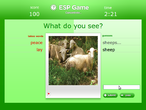ESP game: Difference between revisions
Jump to navigation
Jump to search
(Created page with "{{Citizen science project |field_project_start_date=2004/01/01 |field_project_end_date=2011/09/01 |field_project_open=No |field_subject_areas=Engineering and technology |field...") |
No edit summary |
||
| (3 intermediate revisions by 2 users not shown) | |||
| Line 1: | Line 1: | ||
{{Citizen science project | {{Citizen science project | ||
|field_project_name=ESP game | |||
|field_project_access_URL=http://www.espgame.org/ | |||
|field_screenshot=esp-game.png | |||
|field_software=Citizen science custom software | |||
|field_project_start_date=2004/01/01 | |field_project_start_date=2004/01/01 | ||
|field_project_end_date=2011/09/01 | |field_project_end_date=2011/09/01 | ||
| Line 5: | Line 9: | ||
|field_subject_areas=Engineering and technology | |field_subject_areas=Engineering and technology | ||
|field_cs_subject_areas=other | |field_cs_subject_areas=other | ||
|field_project_description=According to [https://en.wikipedia.org/wiki/Esp_game Wikipedia] (10/2013), The ESP Game is an idea in computer science for addressing the problem of creating difficult metadata. The idea behind the game is to use the computational power of humans to perform a task that computers cannot do (originally, image recognition) by packaging the task as a game. It was originally conceived by Luis von Ahn of Carnegie Mellon University. Google bought a licence to create its own version of the game in 2006 in order to return better search results for its online images. | |field_project_description=According to [https://en.wikipedia.org/wiki/Esp_game Wikipedia] (10/2013), The ESP Game is an idea in computer science for addressing the problem of creating difficult metadata. The idea behind the game is to use the computational power of humans to perform a task that computers cannot do (originally, image recognition) by packaging the task as a game. It was originally conceived by Luis von Ahn of Carnegie Mellon University. | ||
|field_purpose_of_project=Tag a large collection of images in order to find out if participants can help create more accurate image searching and accessibility for visually impaired users | |||
Google bought a licence to create its own version of the game in 2006 called "Image labeler" in order to return better search results for its online images. Google's version was shut down on September 16, 2011 as part of the Google Labs closure in September 2011. | |||
|field_purpose_of_project=Tag a large collection of images with keywords in order to find out if participants can help create more accurate image searching and accessibility for visually impaired users. | |||
|field_research_questions=There are two sets of questions: | |||
* Some are related to the quality of results | |||
* Others are related to good game design. Ahn and Dabash (2006) formulate a set of design rules for designing games with a purpose (GWAPs) | |||
|field_team_leadermm=Luis von Ahn | |||
|field_main_institution=Carnegie Mellon University | |||
|field_team_link=http://www.cs.cmu.edu/~biglou/ | |||
|field_team_location=Carnegie Mellon University | |||
|field_Haklay_typology=crowdsourcing | |||
|field_volonteer_computing=no | |field_volonteer_computing=no | ||
|field_volonteer_thinking= | |field_volonteer_thinking=yes | ||
|field_volonteer_sensing=no | |field_volonteer_sensing=no | ||
|field_volonteer_gaming=no | |field_volonteer_gaming=no | ||
|field_data_types_to_manipulate=pictures | |||
|field_participant_contribution_type=data collection | |||
|field_gaming_elements=achievements | |||
|field_gaming_genre=puzzle | |||
|field_interaction_with_objects=The authors define ESP as GWAP (games with a purpose) and a subgenre "output-agreement games" | |||
Output-agreement games are a generalization of the ESP Game to its fundamental | |||
input-output behavior: | |||
* Initial setup: Two strangers are randomly chosen by the game itself from among all potential players; | |||
* Rules: In each round, both are given the same input and must produce outputs based on the input. Game instructions indicate that players should try to produce the same output as their partners. Players cannot see one another’s outputs or communicate with one another; | |||
* Winning condition: Both players must produce the same output; they do not have to produce it at the same time but must produce it at some point while the input is displayed onscreen. | |||
When the input is an image and the outputs are keyword descriptions of the image, this template becomes the ESP Game | |||
|field_interface_attractivity=somewhat cool/attractive | |||
|field_interface_usability=easy to use | |||
|field_tutorials_documentation=N/A | |field_tutorials_documentation=N/A | ||
|field_peer_to_peer_guidance=N/A | |field_peer_to_peer_guidance=N/A | ||
| Line 18: | Line 46: | ||
|field_research_progress_feedback=N/A | |field_research_progress_feedback=N/A | ||
|field_member_profiles=N/A | |field_member_profiles=N/A | ||
|field_number_of_forum_members=200000 | |||
|field_has_community_manager=N/A | |field_has_community_manager=N/A | ||
|field_project_news_updates=N/A | |field_project_news_updates=N/A | ||
|field_socialsoftware_sites=N/A | |field_socialsoftware_sites=N/A | ||
|field_team_work=N/A | |field_team_work=N/A | ||
|field_completion_level=Low | |||
|field_last_edition=2013/11/05 | |field_last_edition=2013/11/05 | ||
}} | }} | ||
The followup game (Phetch) is more ambitious. According to Ahn et al. (2006): We set our goal to assign proper descriptions to arbitrary images. A “proper” description is correct if it makes sense with respect to the image, and sufficient if it gives enough information about its contents. Phetch will collect sentences | |||
{{Free text}} | {{Free text}} | ||
{{bibliography | |||
|field_author=Luis von Ahn, Shiry Ginosar, Mihir Kedia, Ruoran Liu, Manuel Blum | |||
|field_date=2006 | |||
|field_title=Improving Accessibility of the Web with a Computer Game | |||
|field_reference=Luis von Ahn, Shiry Ginosar, Mihir Kedia and Manuel Blum. Improving Accessibility of the Web with a Computer Game. ACM Conf. on Human Factors in Computing Systems, CHI Notes 2006. pp 79-82. | |||
|field_link=http://www.cs.cmu.edu/~biglou/Phetch.pdf | |||
|field_publication_type=Conference papers | |||
|field_additional_information=Describe Phetch, the followup projects, but includes some discussion of ESP. | |||
}} | |||
{{bibliography | |||
|field_author=Luis von Ahn, Laura Dabbish | |||
|field_title=Designing Games With a Purpose | |||
|field_reference=Luis von Ahn & Laura Dabbish, Games With A Purpose. IEEE Computer Magazine, June 2006. pp 96-98. | |||
|field_publication_type=other | |||
}} | |||
Latest revision as of 10:05, 6 November 2013
The followup game (Phetch) is more ambitious. According to Ahn et al. (2006): We set our goal to assign proper descriptions to arbitrary images. A “proper” description is correct if it makes sense with respect to the image, and sufficient if it gives enough information about its contents. Phetch will collect sentences
| BIBLIOGRAPHY |



